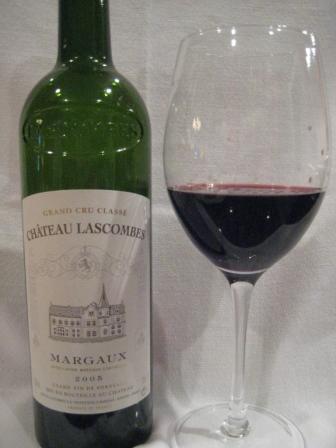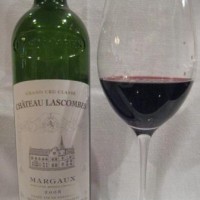Variety: Blend (Cabernet Sauvignon, Merlot, and Petite Verdot)
Country: France
Region: Bordeaux
Sub-region: Left Bank
Appellation: Margaux
Producer/ Vineyard: Chateau Lascombes
 Chateau Lascombes is one of fifteen classified as Seconds Crus (Second Growths) in the original Bordeaux Wine Official Classification of 1855. It is located in the Margaux area, left bank, of Bordeaux. Where right bank wines, Pomerol and St. Emilion, are known for being Merlot heavy, the left bank wines have a greater percentage of cabernet sauvignon. The particular blending percentages vary slightly from year to year depending upon the weather and other factors.
Chateau Lascombes is one of fifteen classified as Seconds Crus (Second Growths) in the original Bordeaux Wine Official Classification of 1855. It is located in the Margaux area, left bank, of Bordeaux. Where right bank wines, Pomerol and St. Emilion, are known for being Merlot heavy, the left bank wines have a greater percentage of cabernet sauvignon. The particular blending percentages vary slightly from year to year depending upon the weather and other factors.
The vineyard stretches over 84 hectares and grows merlot, cabernet sauvignon and petite verdot. The varietals are grown on varying soils within the vineyards to cater to the specific needs of the grapes. The clay-limestone and clay-gravel soils are for the merlot. The clay-limestone and gravel host the cabernet sauvignon. Finally the all gravel soils are reserved for the petite verdot.
Great care is taken in each step of the wine making process to ensure the highest quality. The grapes are harvested by hand and small creates are used to carry them to the winery, as to not cause premature crushing. An interesting pre-fermentation step occurs with the use of cold maceration. The grapes are lightly crushed and cooled to 8 C using a carbon dioxide snow injection method. This is said to produce a more intense, stable color and increased aromatic complexity.
After the fermentation takes place, the wine is then racked into French Oak barrels and aged on the lees, dead or residual yeast, for over 4 months. In addition to building complexity, this helps to round out the tannins and soften them. The barrels are mechanically rotated to keep the lees in suspension and prevent oxidation of the wine. Once the wine is ready, which is determined by almost daily tasting, the almost artistic step of blending occurs. This will allow the wine to demonstrate the best of each varietal. The total aging time is 18 to 20 months before being fined with egg whites and bottled.
The 2005 vintage is made up of 52% Cabernet Sauvignon, 45% Merlot and 3% Petit Verdot. This wine is what you would expect from a second growth on the left bank. The appearance, owning up to its youth, is a luscious, almost opaque, inky purple. The nose boasts of the toasted nuances of French oak. Initially, the tannins are quite evident, again revealing its youth. The wine, however, does unveil a wonderful array of dark fruit, especially blackberry. It has some additional, more subtle, nuances of black licorice and a gamy quality. I suspect this wine will continue to evolve over the next decade, continuing to build its complexity. I look forward to opening it in the future.
In all practicality, this is not an inexpensive wine and it is young. If you are going to drink this wine now, have it with a steak to cut through the tannins and unveil the subtle complexities. We paired it with dark chocolate lava cakes over a blackberry sauce. This made the dark fruit more evident in the wine. Although working well with a chocolate dessert, pair it with a nice filet mignon or rib-eye.
I recommend buying and holding for a special occasion over the next 5 to 10 years. I have a feeling it will be worth the wait. I rated this wine as a B+ over all and a B- for the price. I think it has potential to be an A- if held for a few years. If you want, buy 2 bottles and you can have the best of both now and later.


 Masters of Wine
Masters of Wine Wine and Spirits Education Trust
Wine and Spirits Education Trust